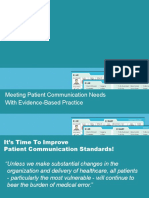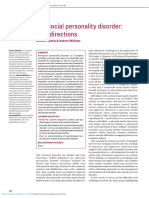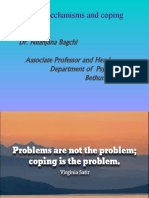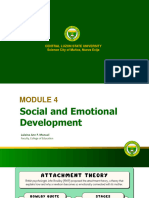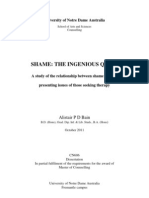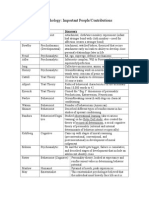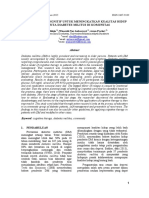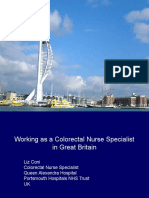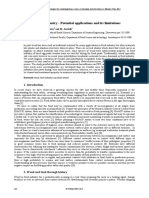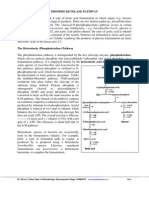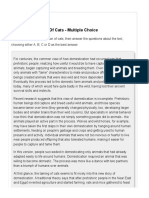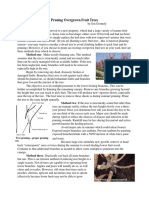Negative Childhood Experiences and Mental Health: Theoretical, Clinical and Primary Prevention Implications
Negative Childhood Experiences and Mental Health: Theoretical, Clinical and Primary Prevention Implications
Uploaded by
Sri EndriyaniCopyright:
Available Formats
Negative Childhood Experiences and Mental Health: Theoretical, Clinical and Primary Prevention Implications
Negative Childhood Experiences and Mental Health: Theoretical, Clinical and Primary Prevention Implications
Uploaded by
Sri EndriyaniOriginal Description:
Original Title
Copyright
Available Formats
Share this document
Did you find this document useful?
Is this content inappropriate?
Copyright:
Available Formats
Negative Childhood Experiences and Mental Health: Theoretical, Clinical and Primary Prevention Implications
Negative Childhood Experiences and Mental Health: Theoretical, Clinical and Primary Prevention Implications
Uploaded by
Sri EndriyaniCopyright:
Available Formats
The British Journal of Psychiatry (2012)
200, 8991. doi: 10.1192/bjp.bp.111.096727
Editorial
Negative childhood experiences
and mental health: theoretical, clinical
and primary prevention implications{
John Read and Richard P. Bentall
Summary
After decades of ignoring or minimising the prevalence and
effects of negative events in childhood, researchers have
recently established that a broad range of adverse childhood
events are significant risk factors for most mental health
problems, including psychosis. Researchers are now
investigating the biological and psychological mechanisms
involved. In addition to the development of a traumagenic
neurodevelopmental model for psychosis, the exploration of
John Read (pictured) is Editor of the journal Psychosis and was Coordinating
Editor of Models of Madness: Psychological, Social and Biological Approaches
to Schizophrenia (Routledge, 2004). Richard Bentall is Professor of Clinical
Psychology at the University of Liverpool. He is the author of Madness
Explained: Psychosis and Human Nature (Penguin, 2003) and Doctoring the
Mind: Why Psychiatric Treatments Fail (Penguin, 2009)
The study by Keyes et al,1 in this issue, represents an important
contribution to our understanding of the processes by which the
maltreatment of children leads to mental health problems. Just
20 years ago, however, it would have been difficult to get the paper
published. Mental health professions have been slow, even resistant,
to recognise the role of childhood adversities in psychiatric
disorder. The 20th century got off to a poor start when Freud
repudiated his original discovery that many of his clients had been
sexually abused and decided, instead, that these disclosures
represented fantasies. As late as 1975, a leading US psychiatry
textbook insisted that the rate of incest was only one per
million. It was not until the end of the century that epidemiological studies revealed the alarming extent to which adults
neglect and abuse children. Pressure to respond to these findings
came more from the womens movement than from psychiatrists
or psychologists. Our introduction of the post-traumatic stress
disorder (PTSD) diagnosis in 1980 was not in response to abused
children, but to Vietnam veterans. By the time we stopped
dismissing disclosures of abuse as fantasies, we were busy
misinterpreting the effects of childhood trauma as symptoms
of a plethora of mental illnesses with predominantly biological
aetiologies. The decade of the brain at the end of the century was
hardly conducive to understanding the long-term effects of childhood adversity, including ironically on the developing brain.
Childhood adveristy and mental health problems
Following this long period of neglect, however, recent studies have
demonstrated that a wide range of adversities, and not just sexual
abuse, are predictors of many forms of mental ill health, and not
just PTSD. These adversities have been found to include: mothers
ill health, poor nutrition and high stress during pregnancy; being
{
See pp. 107115, this issue.
a range of psychological processes, including attachment and
dissociation, is shedding light on the specific aetiologies of
discrete phenomena such as hallucinations and delusions. It
is argued that the theoretical, clinical and primary prevention
implications of our belated focus on childhood are profound.
Declaration of interest
None.
the product of an unwanted pregnancy; early loss of parents via
death or abandonment; witnessing interparental violence;
dysfunctional parenting (particularly affectionless overcontrol);
parental substance misuse, mental health problems and criminal
behaviour; childhood sexual, physical and emotional abuse; childhood emotional or physical neglect; bullying; childhood medical
illness; and war trauma.2,3 Of course, it is very likely that these
types of events have their impact in interaction with other factors
such as heavy cannabis consumption, genetic predisposition and
epigenetic processes.3
Some of these adversities have been shown to be intergenerational, so that parents who themselves suffered in childhood
struggle to provide an optimum environment for their own
children. This finding can be used to counter the argument that
research into intrafamilial causes of mental health problems is
undesirable because it is family blaming. On the contrary, the
findings should encourage us to identify the needs not only of
the identified patient but of parents and other family members,
whose problems often originating in their own childhoods
tend to go unnoticed.
Some of these adversities have also been found to be related to
another powerfully intergenerational phenomenon, poverty,
which has been characterised as the cause of the causes. In their
2009 book, The Spirit Level,4 epidemiologists Richard Wilkinson
and Kate Pickett present convincing evidence that relative poverty
may be an even stronger predictor of mental health than poverty
per se. Countries with the worst disparities between richest and
poorest have the worst outcomes, not only in mental health and
drug misuse but also in physical health, violence, teenage pregnancies
and, importantly for the topic at hand, child well-being.
The range of mental health outcomes for which childhood
adversities are risk factors is equally broad. It might be quicker
to list those not predicted by childhood adversity. Those that are
include: in childhood conduct disorder, attention-deficit
hyperactivity disorder and oppositional defiant disorder; and, in
adulthood depression, anxiety disorders (including generalised
anxiety disorder, phobias and PTSD), eating disorders, sexual
dysfunction, personality disorder, dissociative disorder and
substance misuse.2 Moreover, childhood abuse is related to
severity of disturbance whichever way one defines severity. People
subjected to childhood physical or sexual abuse are more likely to
be admitted to a psychiatric hospital; have earlier, longer and more
89
Read & Bentall
frequent admissions; receive more psychiatric medication; are
more likely to self-harm and to try to kill themselves; and have
higher global symptom severity.3
In another valuable contribution to this literature, in a recent
issue of the Journal, Kessler et al analysed data from 21 countries.2
They concluded that childhood adversities were highly prevalent
and interrelated. They also found that childhood adversities
associated with maladaptive family functioning (e.g. parental
mental illness, child abuse, neglect) were the strongest predictors
of disorders. Of equal importance is their confirmation that
childhood adversities have strong associations with all classes of
disorders and that there is little specificity across disorders. They
acknowledge, however, that the World Mental Health Surveys on
which they based their analyses (as did Wilkinson & Pickett4)
excluded psychosis. Many other studies relating to psychosocial
aetiology exclude psychosis. Nevertheless, it is in this area that
we find the most surprising findings.
supports this general framework, showing, for example, that
victimisation can lead to sensitisation of the dopamine system,
which has long been thought to play a role in psychosis.
At a psychological level, researchers have focused on
mechanisms that might mediate between childhood adversity
and later mental health problems, including attachment,
dissociation, psychodynamic defences, coping responses, impaired
access to social support, and revictimisation.3,8,9 This research has
the potential to uncover specificities in the effects of adversity
which may be difficult to see when only broad diagnoses are considered. For example, childhood sexual trauma appears to have a
specific effect on the risk of hallucinations, which may reflect a
long-term impact on the processes underlying source monitoring
(the ability to differentiate internal and external stimuli); whereas
attachment difficulties and more chronic victimisation, for
example bullying, may increase the risk of paranoid delusions
by affecting the way that individuals appraise unpleasant
experiences.10
Childhood adversity and psychosis
Until very recently the hypothesis that abuse in childhood has a
causal role in psychosis was regarded by many biologically
oriented psychiatrists as heresy. Although the public all over the
world (including patients and their families) place more emphasis
on adverse life events than on genetics or brain abnormalities
when asked about the causes of schizophrenia, David Kingdon
found, in 2004, that for every British psychiatrist who agreed with
the public, 115 thought psychosis is caused primarily by biological
factors.5 Nonetheless, the evidence on the association between
childhood adversity and psychosis has accumulated at a staggering
pace. The first large-scale general population studies did not
appear until 2004.3,6 By 2009 a review3 had identified 11. Ten of
these found that childhood maltreatment is significantly related
to psychosis. The authors of the one exception corrected a flaw
in their original study and found the same as the other ten.7 Nine
of the 11 tested for, and found, a doseresponse relationship.3 For
example, a prospective study in The Netherlands6 found, after
controlling for history of hallucinations or delusions in firstdegree relatives, that people who had been abused as children were
nine times more likely than non-abused people to experience
pathology-level psychosis. The odds ratio for mild abuse was
2.0, but 48.4 for severe abuse.
The 2009 review3 also reported a relationship between
childhood abuse and the actual content of hallucinations and
delusions, as well as research demonstrating that abuse
disclosures by people diagnosed with schizophrenia are reliable.
It cites seven studies of first-episode psychosis that confirm the
relationship between adverse childhood events and negative outcomes. Another review8 concluded: There is now considerable
evidence of an association between child sexual abuse and
psychosis. This relationship is at least as strong as, and may be
stronger than, that with other mental disorders.
Many researchers, such as Keyes and colleagues,1 are now
exploring the mechanisms and processes by which events in
childhood can lead to mental health problems years later. For
example, in an attempt to generate a genuinely integrated
psycho-socio-biological approach,3 the traumagenic neurodevelopmental model9 of psychosis (proposed by J.R. and
colleagues) draws on the evidence that the biochemical and
structural abnormalities found in people diagnosed with
schizophrenia, which have often been portrayed as evidence of a
brain disease, are also found in the brains of traumatised
children. Animal research, in which it has been possible to
examine the effects of adversity in precisely controlled conditions,
90
Implications
The implications of our having finally taken seriously the causal
role of childhood adversity are profound. Clinically, the first step
is to ask about childhood events in order to facilitate meaningful
formulations and comprehensive treatment plans. This is still not
happening routinely in many services.11 The impact of the
introduction of National Health Service guidelines in 2008
remains to be seen.12
The most important implication is in the domain of primary
prevention. George Albee13 put it succinctly:
Primary prevention research inevitably will make clear the relationship between
social pathology and psychopathology and then will work to change social and
political structures in the interests of social justice. It is as simple and as difficult as
that!
John Read, PhD, Department of Psychology, University of Auckland, New Zealand;
Richard P. Bentall, PhD, School of Psychology, University of Liverpool, UK
Correspondence: Professor John Read, Department of Psychology, Private Bag
92019, Auckland, New Zealand. Email: j.read@auckland.ac.nz
First received 14 Jul 2011, accepted 26 Oct 2011
References
1
Keyes KM, Eaton NR, Krueger RF, McLaughlin KA, Wall MM, Grant BF, et al.
Child maltreatment and the structure of common psychiatric disorders.
Br J Psychiatry 2012; 200: 10715.
Kessler RC, McLaughlin KA, Greif Green J, Gruber MJ, Sampson NA, Zaslavsky
AM, et al. Childhood adversities and adult psychopathology in the WHO
World Mental Health Surveys. Br J Psychiatry 2010; 197: 37885.
Read J, Bentall RP, Fosse R. Time to abandon the bio-bio-bio model of
psychosis: exploring the epigenetic and psychological mechanisms by which
adverse life events lead to psychotic symptoms. Epidemiol Psichiatr Soc
2009; 18: 299310.
Wilkinson R, Pickett K. The Spirit Level: Why Equality is Better for Everyone.
Penguin Books, 2010.
Read J, Haslam N, Sayce L, Davies E. Prejudice and schizophrenia: a review
of the Mental illness is an Illness like any other approach. Acta Psychiatr
Scand 2006; 114: 30318.
Janssen I, Krabbendam L, Bak M, Hanssen M, Vollebergh W, De Graaf R, et al.
Childhood abuse as a risk factor for psychotic experiences. Acta Psychiatr
Scand 2004; 109: 3845.
Cutajar M, Mullen P, Ogloff J, Thomas S, Wells D, Spataro J. Schizophrenia
and other psychotic disorders in a cohort of sexually abused children. Arch
Gen Psychiatry 2010; 67: 11149.
Negative childhood experiences and mental health
8 Bebbington P. Childhood sexual abuse and psychosis: aetiology and
mechanism. Epidemiol Psichiatr Soc 2009; 18: 28493.
11 Read J, Hammersley P, Rudegeair T. Why, when and how to ask about child
abuse. Adv Psychiatr Treat 2007; 13: 10110.
9 Read J, Perry B, Moskowitz A, Connolly J. The contribution of early traumatic
events to schizophrenia in some patients: a traumagenic
neurodevelopmental model. Psychiatry 2001; 64: 31945.
12 NHS Confederation. Briefing 162: Implementing National Policy on Violence
and Abuse. Ministry of Health, 2008.
10 Bentall RP, Fernyhough C. Social predictors of psychotic experiences:
specificity and psychological mechanisms. Schizophr Bull 2008; 34: 101220.
13 Albee GW. Revolutions and counter-revolutions in prevention. Am Psychol
1996; 51: 11303.
psychiatry
in pictures
Ashanti fertility dolls (Akuaba)
Malcolm P. Weller
Belief in myths allows the comfort of opinion without the discomfort of thought.
John F. Kennedy
In superstitions, intuitive concepts and spurious attribution coexist with acquired rational
knowledge. In animals superstitious learning based on intermittent rewards, unlike the
withdrawal of predictable reward, is difficult to extinguish.
It might be thought that increasing environmental control would reduce reliance on
unverified beliefs. Nevertheless, despite the conflict with religious prohibitions, in
American society approximately one quarter believe in astrology, clairvoyance, ghosts
and communication with the dead. Such beliefs, and good-luck charms, are often
important parts of peoples lives.
Akuaba (from Akua, a day-name for a female born on a Wednesday, and ba, child;
hence, Akuas child) refers to the fertility doll carved from wood by the Ashanti (more
correctly, Asante), a major ethnic group of the Ashanti Region of Ghana. At their height
they dominated most of Ghana, as well as parts of Togo and the Ivory Coast.
Fertility dolls are recommended by a herbalist, or generally a priest, and the woodcarver
has high status, reinforcing prevailing belief. Like normal children, they are dressed and
tied to the back, or form part of a home shrine when not being carried.
The line of descent in Ashanti culture is matrilineal. Dolls are thought to represent an ideal of feminine beauty, the likelihood of
having a beautiful female child being increased in those who carry the doll. Accordingly, the dolls were also carried by pregnant
women, but more often by infertile women. Apart from the normal desire for motherhood, infertility could raise suspicions of
witchcraft. Because of the premium on fertility and the stress of infertility, associated physiological perturbations might be
thought to aggravate infertility.
Anecdotal evidence suggests that womens fertility is lower in stressful circumstances and that conception is more frequent
during or after a holiday, or after adoption, following a protracted period of infertility. The idea that stress limits fertility would
be a natural barrier to population expansion at times of drought and famine and would be a mechanism for balancing population
to resources. In support of these ideas, extreme weight loss, as in anorexia nervosa, leads to amenorrhea. Ovulation in the Kung!
of the Northern Kalahari desert area of Botswana, a non-contraceptive using population with a low fertility and a birth space
interval of greater than 3 years, is linked to the rains, but otherwise there is no evidence to support these suppositions in
humans when objective data are rigorously analysed, even in artificial fertility treatment.
It is estimated that one in three or four Ashanti women possessed a doll. Ironically, fertility in Ghana is low compared with most
other African countries. The elevation of anecdote over evidence might be summarised in the present example by saying that the
wish to mother is the thought.
With grateful thanks to Adrian Bird for valuable input and helpful discussion.
References available on request to Professor Malcolm P. Weller, School of Health and Social Sciences, Middlesex University,
email: psychiatry@weller.tv. Image s Skeptiseum. Reproduced with permission.
The British Journal of Psychiatry (2012)
200, 91. doi: 10.1192/bjp.bp.111.096073
91
Negative childhood experiences and mental health: theoretical,
clinical and primary prevention implications
John Read and Richard P. Bentall
BJP 2012, 200:89-91.
Access the most recent version at DOI: 10.1192/bjp.bp.111.096727
References
Reprints/
permissions
You can respond
to this article at
Downloaded
from
This article cites 11 articles, 4 of which you can access for free at:
http://bjp.rcpsych.org/content/200/2/89#BIBL
To obtain reprints or permission to reproduce material from this paper, please
write to permissions@rcpsych.ac.uk
/letters/submit/bjprcpsych;200/2/89
http://bjp.rcpsych.org/ on March 2, 2016
Published by The Royal College of Psychiatrists
To subscribe to The British Journal of Psychiatry go to:
http://bjp.rcpsych.org/site/subscriptions/
You might also like
- Shadow Work Embracing The Hidden Aspects of Self For Personal GrowthDocument3 pagesShadow Work Embracing The Hidden Aspects of Self For Personal GrowthAnniey MwangiNo ratings yet
- Vidatak EZ BoardDocument42 pagesVidatak EZ BoardSri EndriyaniNo ratings yet
- WorkbookDocument4 pagesWorkbookYoseph Ayele0% (1)
- The Four Quadrant Model PDFDocument2 pagesThe Four Quadrant Model PDFAlex KataNaNo ratings yet
- Vidatak EZ BoardDocument42 pagesVidatak EZ BoardSri EndriyaniNo ratings yet
- 9Th Class Biological Science: Bit BankDocument17 pages9Th Class Biological Science: Bit BankRaviNo ratings yet
- A Salutogenic Mental Health Model Flourishing As ADocument13 pagesA Salutogenic Mental Health Model Flourishing As AAna EclipseNo ratings yet
- Family Const JohnPaineDocument5 pagesFamily Const JohnPaineMarcelo Torres DaraioNo ratings yet
- Anger 2018Document18 pagesAnger 2018Paulina Grosu100% (1)
- Buddhist Meditation Flow and RitualDocument21 pagesBuddhist Meditation Flow and RitualGulabNo ratings yet
- The Shadow From A Buddhist PerspectiveDocument14 pagesThe Shadow From A Buddhist PerspectiveGuilherme Simão100% (1)
- GAD 9 2015 UncertaintyDocument7 pagesGAD 9 2015 UncertaintyShahed FacebookNo ratings yet
- Emotional Regulation SkillsDocument8 pagesEmotional Regulation Skillsjuliana3caperuttoNo ratings yet
- Psychology AssignmentDocument7 pagesPsychology Assignmentnaveed100% (1)
- Hendricks, LaVelle The Effects of Anger On The Brain and Body NFJCA V2 N1 2013Document12 pagesHendricks, LaVelle The Effects of Anger On The Brain and Body NFJCA V2 N1 2013Antonio HortonNo ratings yet
- Anger: Somatic AffectiveDocument2 pagesAnger: Somatic AffectiveFira Dewi Cahyani100% (1)
- 10 Signs Emotionally Immature ParentDocument1 page10 Signs Emotionally Immature ParentSolomon LeBlancNo ratings yet
- 1992 - Liotti - Egocentrismo y Terapia Cognitiva de Los Trastorno de La PersonalidadDocument17 pages1992 - Liotti - Egocentrismo y Terapia Cognitiva de Los Trastorno de La PersonalidadVicente Fasce OlmosNo ratings yet
- Patterns_of_Parentification_Health_and_Life_SatisfactionDocument17 pagesPatterns_of_Parentification_Health_and_Life_Satisfactionjlu08521No ratings yet
- The Emotional-TriggersDocument2 pagesThe Emotional-Triggerssushika100% (1)
- Antisocial Personality DisorderDocument12 pagesAntisocial Personality DisorderMaría Isabel Trujillo MayaNo ratings yet
- 1 5100511802756694954Document173 pages1 5100511802756694954Rafles PinheiroNo ratings yet
- Negative Capability and The Capacity To Think in The Present MomentDocument12 pagesNegative Capability and The Capacity To Think in The Present Momenttomor2100% (2)
- Ikigai - The Japanese Secret To A Long and Happy Life by Héctor García - Francesc MirallesDocument3 pagesIkigai - The Japanese Secret To A Long and Happy Life by Héctor García - Francesc MirallesArjun Meghanathan100% (1)
- Adler OutlineDocument8 pagesAdler Outlinem_aldhahriNo ratings yet
- The Relationship Between Anxiety and Self-Esteem Among Senior High School StudentsDocument8 pagesThe Relationship Between Anxiety and Self-Esteem Among Senior High School StudentsCRESCHAN JE VILLANUEVANo ratings yet
- False VS True SelfDocument8 pagesFalse VS True SelfAnjanette TenorioNo ratings yet
- Self Psychology ReviewDocument5 pagesSelf Psychology ReviewReggeloNo ratings yet
- 09 - Kohut & Wolf - 1978 - The Disorders of The Self and Their TreatmentDocument13 pages09 - Kohut & Wolf - 1978 - The Disorders of The Self and Their TreatmentRebeca Urbon100% (1)
- Working With Victims: Being Empathic HelpersDocument12 pagesWorking With Victims: Being Empathic HelpersАнтон ГромовNo ratings yet
- Defense MechanismsDocument43 pagesDefense MechanismseinsteinNo ratings yet
- A Skin For The ImaginalDocument25 pagesA Skin For The ImaginalCarla SantosNo ratings yet
- How To Stop Ruminating 10 Tips To Stop Repetitiv 2Document2 pagesHow To Stop Ruminating 10 Tips To Stop Repetitiv 2Swarnali BoseNo ratings yet
- Edit - Blog 8 - How To Break A Trauma BondDocument3 pagesEdit - Blog 8 - How To Break A Trauma Bondiqra.nazNo ratings yet
- How To Be YourselfDocument1 pageHow To Be YourselfyuliyamsNo ratings yet
- The Power of Empathy. Mia LeijssenDocument7 pagesThe Power of Empathy. Mia LeijssenDarryl Louie LabialNo ratings yet
- Social Anxiety, Assessment Spin - Full - .Tahoma - 0 PDFDocument2 pagesSocial Anxiety, Assessment Spin - Full - .Tahoma - 0 PDFSana SajidNo ratings yet
- Module 4 - Part 3 - SED 2100Document15 pagesModule 4 - Part 3 - SED 2100kylieNo ratings yet
- How To Overcome ShameDocument2 pagesHow To Overcome ShameMas PramNo ratings yet
- Automatic Negative Thoughts and Core BeliefsDocument5 pagesAutomatic Negative Thoughts and Core BeliefsJose miguel Sanchez gutierrez100% (3)
- Inner DialogueDocument28 pagesInner DialoguekwongNo ratings yet
- Accurate Expression and Validation 2010Document30 pagesAccurate Expression and Validation 2010Paul ScallanNo ratings yet
- Axis I Clinical Psychiatric Disorders - LMM-1Document11 pagesAxis I Clinical Psychiatric Disorders - LMM-1richhuangNo ratings yet
- BPD Otto KernbergDocument4 pagesBPD Otto KernbergAlejandra VNo ratings yet
- Shame - The Ingenious Quilt Dissertation M CounsDocument112 pagesShame - The Ingenious Quilt Dissertation M CounsAlistair P D BainNo ratings yet
- Enneagram 4 MBTIDocument3 pagesEnneagram 4 MBTIMoon5627No ratings yet
- Analyze The Probability of A Feared EventDocument7 pagesAnalyze The Probability of A Feared Eventmmcgreger100% (1)
- Personality TraitsDocument12 pagesPersonality TraitsjhumliNo ratings yet
- Theorist NamesDocument4 pagesTheorist Namesapi-234527349No ratings yet
- Reality Therapy: Key ConceptsDocument5 pagesReality Therapy: Key ConceptsfaraNo ratings yet
- Jung's Concept of The Anima:Animus - Enlightening or Frightening?Document2 pagesJung's Concept of The Anima:Animus - Enlightening or Frightening?Diana SolanoNo ratings yet
- Trauma, Dissociationand Disorganized Attachment LiottiDocument40 pagesTrauma, Dissociationand Disorganized Attachment LiottiFrancisca Nilsson RodríguezNo ratings yet
- ReportDocument14 pagesReportTulika KumarNo ratings yet
- Gestalt Peeling The Onion Csi Presentatin March 12 2011Document6 pagesGestalt Peeling The Onion Csi Presentatin March 12 2011Adriana Bogdanovska ToskicNo ratings yet
- Psychoanalytic Theory: (Sigmund Freud)Document10 pagesPsychoanalytic Theory: (Sigmund Freud)Trixie MalinaoNo ratings yet
- Rumination Vs ReflectionDocument1 pageRumination Vs ReflectionАнна ИвановаNo ratings yet
- ADOLESCENCEDocument4 pagesADOLESCENCECherry BobierNo ratings yet
- GestaltDocument20 pagesGestaltnira_110100% (2)
- How To Deal With Values Conflicts' - by Russ HarrisDocument9 pagesHow To Deal With Values Conflicts' - by Russ HarrisMaria Salve Obar BobisNo ratings yet
- Piaget's Constructivist TheoryDocument22 pagesPiaget's Constructivist TheoryLoudene LouwNo ratings yet
- VIVIN CANDRA IKAWAT-SULASTRI Fix PDFDocument8 pagesVIVIN CANDRA IKAWAT-SULASTRI Fix PDFSri EndriyaniNo ratings yet
- HIV, Stigma & Discrimination: 2012 Third EditionDocument61 pagesHIV, Stigma & Discrimination: 2012 Third EditionSri EndriyaniNo ratings yet
- Dukungan Sosial Dan Kecemasan Pada Pasien Diabetes Melitus JauhariDocument13 pagesDukungan Sosial Dan Kecemasan Pada Pasien Diabetes Melitus JauhariSri Endriyani100% (1)
- Model Terapi Kognitif Untuk Meningkatkan Kualitas Hidup Penderita Diabetes Militus Di KomunitasDocument8 pagesModel Terapi Kognitif Untuk Meningkatkan Kualitas Hidup Penderita Diabetes Militus Di KomunitasSri EndriyaniNo ratings yet
- Teacher Guide - Assertiveness PDFDocument6 pagesTeacher Guide - Assertiveness PDFSri EndriyaniNo ratings yet
- Therapeutic Communication Pourpoint New 2Document20 pagesTherapeutic Communication Pourpoint New 2Sri EndriyaniNo ratings yet
- NyeriDocument3 pagesNyeriSri EndriyaniNo ratings yet
- Undertreatment of Mental Health Problems in Adults With Diagnosed Diabetes and Serious Psychological DistressDocument4 pagesUndertreatment of Mental Health Problems in Adults With Diagnosed Diabetes and Serious Psychological DistressSri EndriyaniNo ratings yet
- Who MC Topic-11Document55 pagesWho MC Topic-11Sri EndriyaniNo ratings yet
- Caring For A Family Member With Schizophrenia: The Experience of Family Carers in IndonesiaDocument10 pagesCaring For A Family Member With Schizophrenia: The Experience of Family Carers in IndonesiaSri EndriyaniNo ratings yet
- Perilaku IbuDocument2 pagesPerilaku IbuSri EndriyaniNo ratings yet
- Colorectal NursesDocument29 pagesColorectal NursesSri EndriyaniNo ratings yet
- Does Nursing Science Exist? A View From SeattleDocument42 pagesDoes Nursing Science Exist? A View From SeattleSri EndriyaniNo ratings yet
- International Rice Research Newsletter Vol12 No.3Document56 pagesInternational Rice Research Newsletter Vol12 No.3ccquintosNo ratings yet
- Membrane Structure and FunctionDocument35 pagesMembrane Structure and FunctionNi AhdaNo ratings yet
- Wood in Food IndustryDocument7 pagesWood in Food Industrymnegm2890No ratings yet
- Sop RFDocument4 pagesSop RFayalajobelle2No ratings yet
- Practical Gas ChromatographyDocument904 pagesPractical Gas Chromatographybluedolphin7100% (1)
- Udvabito Krishi Projukti 2017-18 (Technology & Variety) PDFDocument116 pagesUdvabito Krishi Projukti 2017-18 (Technology & Variety) PDFRayan JacobNo ratings yet
- DLL SCIENCE-5 Q2 W7-EdittedDocument16 pagesDLL SCIENCE-5 Q2 W7-Edittedkassy3521No ratings yet
- Stem CellDocument8 pagesStem Cellapi-220278259No ratings yet
- Braden Q Scale:: Intensity and Duration of Pressure ScoreDocument1 pageBraden Q Scale:: Intensity and Duration of Pressure Scoresholihatul fuadahNo ratings yet
- Molecular Techniques in Food Biology: Safety, Biotechnology, Authenticity and Traceability First Edition El Sheikha Download PDFDocument60 pagesMolecular Techniques in Food Biology: Safety, Biotechnology, Authenticity and Traceability First Edition El Sheikha Download PDFganniyorlay100% (10)
- Valuing The Suitable Agro-Industrial Wastes For Cultivation of P. Platypus and P. EousDocument4 pagesValuing The Suitable Agro-Industrial Wastes For Cultivation of P. Platypus and P. EousDinesh Babu PugalenthiNo ratings yet
- Evaluation and Management of Suspected Sepsis and Septic Shock in AdultsDocument54 pagesEvaluation and Management of Suspected Sepsis and Septic Shock in Adultsdcaguayaa100% (1)
- Separation of Amino Acids by Paper Chromatography: Biol. 261Document4 pagesSeparation of Amino Acids by Paper Chromatography: Biol. 261Jeff LinksNo ratings yet
- General Biology 1 Las Aeroboc RespirationDocument6 pagesGeneral Biology 1 Las Aeroboc Respirationkevinbrentd30No ratings yet
- Phospho Ketolase PathwayDocument2 pagesPhospho Ketolase PathwayDr. SHIVA AITHAL100% (1)
- (Marisa Cordella, Aldo Poiani (Auth.) ) Behavioural PDFDocument816 pages(Marisa Cordella, Aldo Poiani (Auth.) ) Behavioural PDFAnonymous YdFUaW6fB100% (2)
- Complete Syllabus of Class XI & XII: Botany (Medical)Document6 pagesComplete Syllabus of Class XI & XII: Botany (Medical)Abhijeet ParkhiNo ratings yet
- Soal Bahasa InggrisDocument4 pagesSoal Bahasa InggrisSon NeptunusNo ratings yet
- Pdf24 Converted 2Document3 pagesPdf24 Converted 2Lê Mai Bảo VyNo ratings yet
- THC Detection WindowDocument16 pagesTHC Detection Windowashgee1No ratings yet
- Soil Plant Water RelationshipsDocument27 pagesSoil Plant Water Relationshipskharladrian100% (1)
- Robson 2007 AsianmyrmecologyDocument20 pagesRobson 2007 AsianmyrmecologyRika LauraNo ratings yet
- I. Cutting and DissectingDocument10 pagesI. Cutting and DissectingApple MaeNo ratings yet
- Unit 2 - SBI3U GeneticsDocument113 pagesUnit 2 - SBI3U GeneticssleepNo ratings yet
- Liu Et Al 2023 Grass Legume Mixtures Maintain Forage Biomass Under Microbial Diversity Loss Via Gathering PseudomonasDocument17 pagesLiu Et Al 2023 Grass Legume Mixtures Maintain Forage Biomass Under Microbial Diversity Loss Via Gathering PseudomonasalikiolibarrioNo ratings yet
- Standard Operating Procedures (SOP) For B360C BSL2 Cell Culture RoomDocument4 pagesStandard Operating Procedures (SOP) For B360C BSL2 Cell Culture RoomvisiniNo ratings yet
- Transcription and Translation Simulation WorksheetDocument4 pagesTranscription and Translation Simulation WorksheetDonna NNo ratings yet
- Young Peach Tree Pruning GuideDocument2 pagesYoung Peach Tree Pruning GuideSteve AldenNo ratings yet
- 3 Year Architecture: World Day of Architecture 2017 OCTOBER 7-8, 2017Document8 pages3 Year Architecture: World Day of Architecture 2017 OCTOBER 7-8, 2017Jimin ReyesNo ratings yet




